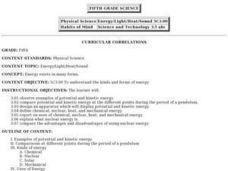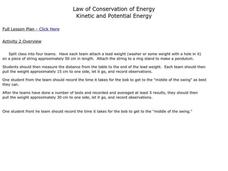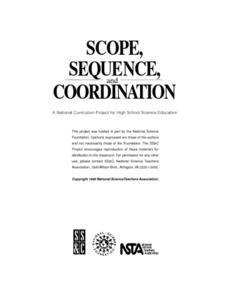Curated OER
Swinging Pendulum
Students engage in an activity which demonstrates how potential energy (PE) can be converted to kinetic energy (KE) and back again. Given a pendulum height, students calculate and predict how fast the pendulum will swing by understanding...
Curated OER
Pendulums
First-time physicists experiment with pendulums in this physics activity. They vary the weight of the bob, record how long each takes to complete ten period swings, and then calculate the time for one period. They repeat the procedure,...
Curated OER
Energy, Light, Heat, and Sound
Fifth graders investigate various forms of energy. They compare potential and kinetic energy at different points during the period of a pendulum, design an apparatus that displays potential and kinetic energy, and analyze the advantages...
Curated OER
Law of Conservation of Energy Kinetic and Potential Energy
Eighth graders are able to understand the concepts of the law of conservation of energy and the principles of kinetic and potential energy, including understanding the principles behind the law and it's various applications. They...
Curated OER
Amusement Park Physics
Students conduct a series of experiments on conservation of energy and momentum. In this physics lesson, students investigate the factors affecting the period of the pendulum. They build a roller coaster and calculate the marble's...
Curated OER
Boarding School
Students discuss conservation of energy using a skateboarder in the halfpipe or a person on a roller coaster as an example. Using mathematical equations, students examine potential and kinetic energy of the examples. Lesson is completed...
Curated OER
Kinetic Vs. Potential Energy
Eighth graders listen to a teacher lecture and observe a demonstration of both potential energy and stored energy. After discussing the characteristics and examples of different types of energy, 8th graders make predictions and then...
Curated OER
Qualitative Aspects of Rotational Dynamics
Explanations for six different physics lab activities and five suggested assessments are contained in this resource by the National Science Teachers Association. Any combination can be used to open learners' eyes to rotational motion....
Curated OER
Science: Einstein's Big Idea
Students explore the various aspects of Einstein's energy equation and discover how energy is transferred from one form to another. In teams, they rotate through seven stations to experience such aspects of energy change through...
Curated OER
Energy
Young scholars distinguish between kinetic an potential energy. They recognize that energy is conserved when changing from one form to another. Students compare the scientific meaning of work with its everyday meaning.
Curated OER
Ballistic Pendulum Lab
Students determine the muzzle velocity of projectile launcher. In this physics lesson plan, students compare the pendulum method and kinematic method in calculating the initial velocity. They analyze data and discuss results in class.
Curated OER
Simple Harmonic Motion
Students explore the theory of simple harmonic motion (SHM) by performing hands-on, practical application experiments. In this harmonic motion lesson, students use strings of various lengths and bobs of different weights to create a...
Curated OER
Simple Harmonic Motion
Learners explain the theory of simple harmonic motion (SHM) by performing hands-on, practical application experiments.
Curated OER
Simple Harmonic Motion
Learners study harmonic motion and its oscillation. In this simple harmonic motion lesson students demonstrate a series of regular oscillations and explain the theory behind the experiment.















